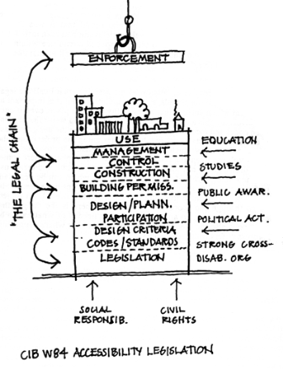
We are trying to persuade the owners of those buildings to make the necessary
changes and even to involve the costs themselves. When altering an existing
public building it immediately has to comply with the current law.
Safaa Issa
I would like to comment on the cost of remodelling old or existing buildings
from the United States experience. Their experience has shown that this cost
has been between 3 and 16 per cent of the total cost of the building. This also
takes into consideration the lost time of productivity while using this building
for remodelling and changing it to an accessible one.
Alexander Phiri
The presence or absence of strong organizations of persons with disabilities
is often decisive. For example, in Bulawayo, the hub of the disability movement
in the country, there is the spirit and the consciousness. We just knock on
the door and our city counsellors give us a good ear. But in the rural areas
it is pathetic. There is a lot of development going on, it has been going on
since independence: community hall, schools including hospitals, but they are
not accessible.
Sven Thiberg
What we are trying to find is a system which functions without strong disability
movements, which functions by its own.
Adolf Ratzka
I would like to draw the parallel to the area of fire safety. Does compliance
with regulations for fire safety in buildings depend on the existence of a local
citizen's group for fire safety? When I had difficulties with my own apartment
in Stockholm. As an ordinary flat in a multi-family structure it should have
been completely wheelchair accessible. I called up the building inspector and
asked, "How could you overlook these thresholds of 7.5 cm when the law specifies
a maximum of only 3 cm?" He said, "We have too much to do, all we manage to
check is fire safety". So the question is, how does accessibility get the same
status as fire safety? Perhaps one strategy could be to have one general heading,
Safety, which includes both fire safety and those aspects which we consider
necessary in order to safely gain access into a building.
Phillip Thompson
I think you have to look realistically about the process which generates any
laws or building regulations. Fire safety and any other regulation is actually
a function of public demand. Fire safety legislation came about by virtue of
bad experience in buildings where people did not manage to escape. Regrettably,
we can not rely on the general public to provide that demand. We as the consumers
in this instance have to provide the demand for the legislation. Although it
is a very nice concept to develop legislation that is self-enacting, in practice
it would be very difficult.
We all need the development of legislation to move in a normal way but I think
if interested groups do not put forward their concerns, society will not take
heed of their needs. I think that is the whole idea why we have civil rights
movements and movements for liberation from colonial rule.


